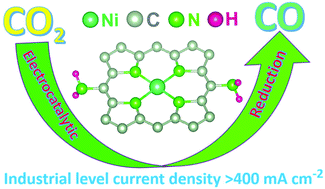Amination strategy to boost the CO2 electroreduction current density of M–N/C single-atom catalysts to the industrial application level†
Abstract
Although the Faraday efficiency (FE) for CO production of single-atom catalysts immobilized on nitrogen-doped carbon supports (M–N/C) for the CO2 electrocatalytic reduction reaction (CO2RR) is generally over 90%, M–N/C catalysts demonstrate a poor reaction current density, which is much worse than the current density at the industrial level. Herein, we first report a generalized amination strategy to significantly increase the current density for CO production of M–N/C catalysts (M = Ni, Fe, Zn). Among them, the aminated Ni single-atom catalyst achieves a remarkable CO partial current density of 450 mA cm−2 (a total current density over 500 mA cm−2) with a nearly 90% CO FE at a moderate overpotential of 0.89 V, and particularly CO FE can be maintained over 85% in a wide operating potential range from −0.5 V to −1.0 V. DFT calculations and experimental research demonstrate that the superior activity is attributed to enhanced adsorption energies of CO2* and COOH* intermediates caused by the regulation of the electronic structure of the aminated catalysts. This work provides an ingenious method for significantly increasing the current density at the industrially-relevant level of single-atom catalysts for the CO2RR.



 Please wait while we load your content...
Please wait while we load your content...